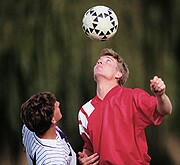
TUESDAY, Nov. 13 (HealthDay News) — Soccer is an extremely popular team sport, and one of the few that doesn’t require any protective head gear. But, a small study of professional soccer players from Germany suggests that even in players without evidence of a serious head injury, playing soccer may cause changes to certain areas of the brain.
“We used sophisticated MR imaging to investigate the white matter in the brains of professional soccer players who had no symptoms and no known concussions, and compared to a group of swimmers, we found white matter changes in the brain,” said the study’s lead author, Dr. Inga Koerte. She is a visiting senior research fellow at Harvard Medical School’s psychiatry neuroimaging laboratory in Boston, and a senior research fellow at Ludwig-Maximilians University in Munich, Germany.
“These changes have been found in other players in contact sports. They were subtle, but they were there. It’s difficult to say if symptoms will develop in the future, but the changes are in regions of the brain that are important for things like memory and attention,” she explained.
Results of the study are published as a research letter in the Nov. 14 issue of the Journal of the American Medical Association.
More than 250 million children and adults play soccer, making it the most popular sport in the world, according to background information in the study. And, it’s the only sport where the unprotected head is a primary point of contact with the ball.
The potential problems linked to traumatic brain injuries, such as concussions, are fairly well known. What isn’t clear is if repeated blows to the head that don’t result in obvious injuries can lead to brain damage.
To get an idea of whether or not playing soccer could lead to any changes in the brain, Koerte and her colleagues recruited 12 professional German soccer players who had been training since they were children for a professional sports career, and compared them to a group of swimmers, a sport with a low risk of head trauma.
Both the soccer players and swimmers underwent an imaging scan called high-resolution diffusion tensor imaging that provides detailed images of the brain. The researchers had neuroradiologists look at the scans, and none was found to be abnormal.
But, there were differences in the structure of the white matter in the brain. White matter is the communication network that transmits messages between neurons (gray matter) in the brain.
Study senior author Martha Shenton, a professor of psychiatry at Harvard Medical School, noted that the researchers don’t know what caused the changes in the white matter of the soccer players, only that there were changes. “It could be from heading the ball, or due to impact of hitting other players or from sudden acceleration,” she said.
Both study authors said they wouldn’t discourage children from playing soccer at a recreational level, but that more study needs to be done to see if these changes cause any long-term damage.
Dr. Jeffrey Bazarian, an associate professor of emergency medicine at the University of Rochester Medical Center in New York, agreed that this study shouldn’t cause parents to worry about their child heading a soccer ball. He said in professional players, head-to-head contact is a much more likely cause of brain injury.
“It’s also important to remember that when you ask athletes whether they’ve had a concussion before, they may underreport injuries. If they have a concussion, it means they can’t play. Plus, they don’t always know if they’ve had a concussion,” he said.
“Trying to answer this question is very important, but following athletes forward in time, rather than back, would be more likely to give us the answer,” Bazarian said.
More information
Read what the Institute of Medicine has to say about head injuries in children’s soccer.

